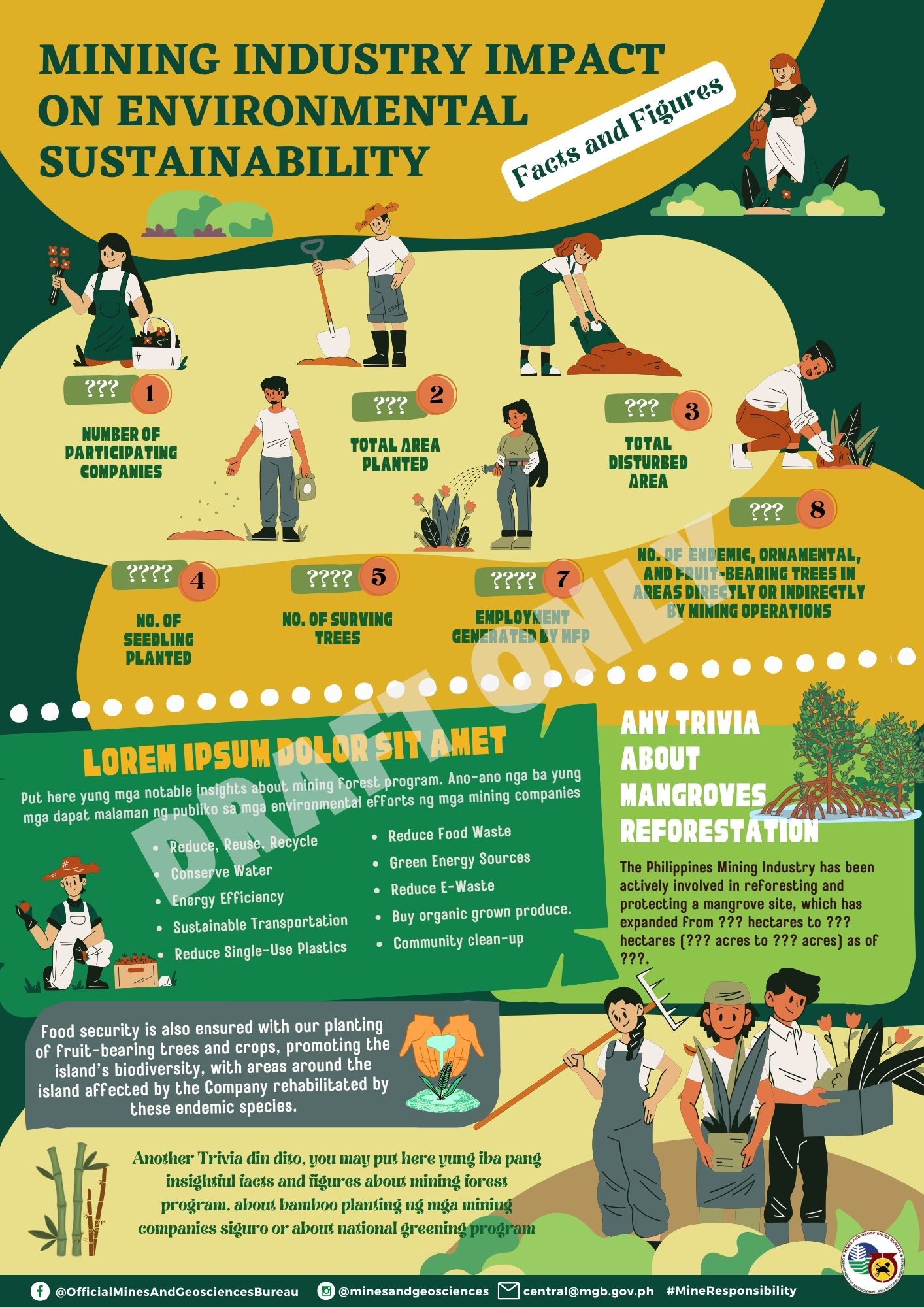Environmental Protection and Enhancement Program

The Environmental Protection and Enhancement Program (EPEP) is a comprehensive and strategic environmental management plan prepared by the Contractor/Permit Holder which shall provide a description of the expected and considered acceptable impacts and shall set out the life-of-mine environmental protection and enhancement strategies based on best practice in environmental management in mining during development and utilization stages. The activities under the EPEP shall aim to protect the land, water, air, and other natural resources from the adverse effects of mining/mineral processing. It also intends to develop the affected area towards a selfsustaining environment. Through this, Contractors and Permit Holders are expected to ensure that the potential negative impacts of their mining/mineral processing projects are regulated based on the concept of “Mitigation Hierarchy,” which includes avoidance, minimization and mitigation of identified negative impacts of mining/mineral processing, as a compliance with the existing laws, rules and regulations. In addition, when the proposed practices are unproven, a research program to prove the impact control and rehabilitation technology shall be required.
Legal Basis
The following are the legal bases for the preparation, submission, and implementation of EPEP:
- Section 69 of Republic Act (RA) No. 7942, the Philippine Mining Act of 1995;
- Sections 167, 169, and 178 of the DENR Administrative Order (DAO) No. 2010-21, as amended, "Providing for a Consolidated Department of Environment and Natural Resources Administrative Order for the Implementing Rules and Regulations of Republic Act No. 7942, Otherwise Known as the Philippine Mining Act of 1995;"
- DAO No. 2018-19, the Guidelines for Additional Environmental Measures for Operating Surface Metallic Mines;
- Presidential Decree No. 1586, the Philippine Environmental Impact Statement System (PEISS) and its Implementing Rules and Regulations (IRR), DAO No. 2003-30;
- DAO No. 2015-02, the Harmonization of the Implementation of the PEISS and the Philippine Mining Act of 1995 in Relation to Mining Projects; and
- Other environmental laws, rules and regulations such as RA No. 8749 (Philippine Clean Air Act of 1999), RA No. 9275 (Philippine Clean Water Act of 2004) and Presidential Decree (PD) No. 705 (Revised Forestry Code).
Scope
All Contractors and Permit Holders are required to implement an EPEP during the development and utilization stages of mining/mineral processing operation.
The EPEP shall cover all activities related to environmental protection and enhancement as mitigating measures on the identified possible environmental impacts on land, water, air and noise caused by mining/mineral processing operations. To be able to provide operational link between the environmental management and mining operations/mineral processing; and to attain the approved post-mining land use, the EPEP shall be harmonized with the mine/mineral processing plan/program (i.e. 3-Year Development and Utilization Work Program for mining, 5-Year Development and Utilization Work Program for mineral processing) and the Final Mine Rehabilitation and/or Decommissioning Plan.
These guidelines provide a blueprint for the Contractors and Permit Holders in the preparation and implementation of the EPEP; and for the Mines and Geosciences Bureau (MGB) Central Office (CO) and Regional Office (RO) in the review, evaluation, monitoring and audit of the implementation of the EPEP.
{slider- epep title="Guiding Principles"}
The implementation of the EPEP shall adhere to the principles of sustainable development in environmental management for the protection of the environment and other natural resources. Moreover, to ensure the elimination, reduction and mitigation of the effects of the development and utilization of mineral resources to the environment, the formulation and implementation of the EPEP shall be in accordance with the governing principles stated in DAO No. 2010-21.
Consequently, mining and mineral processing operations shall be guided by the following principles:
1. Principles of Sustainable Development and Sustainability
Sustainable development is defined as the development that meets the needs of the present generation without compromising the ability of future generations to meet their own needs (Brundtland, 1987).
Sustainability, on the other hand, entails a systems-based approach of understanding the interactions among environmental, social and economic pillars (Figure No. 1).

Figure No. 1. Three Pillars of Sustainability (United Nations World Summit on Sustainable Development, 2002)
Mining and mineral processing activities shall be conducted in a manner that contributes to the Sustainable Development Goals - the universal call to action to end poverty, protect the planet and improve the lives and prospects of everyone. In general, the following aspects in relation to SDGs shall be highlighted in the conduct of mining and mineral processing and in the implementation of the EPEP: protection and conservation of life on land, provision of clean water and sanitation, use of energy efficient activities/processes, implementation of measures that will address climate-related environmental impacts, and creation of jobs and economic growth.
Mitigation Hierarchy and Precautionary Principle
The mitigation hierarchy (Figure No. 2) is a tool for managing risks and potential impacts mainly to biodiversity and ecosystem services which involves three key actions – avoid, minimize and restore (The Biodiversity Consultancy, 2015). In relation to the concept of mitigation, the Precautionary Principle implies that in case of threats of serious or irreversible damage to the environment, absence of scientific certainty shall not result in lenient implementation of cost-effective measures (United Nations Rio Declaration, 1992).

Figure No. 2. Mitigation Hierarchy (The Biodiversity Consultancy, 2015)
Contractors/Permit Holders shall consider the three key actions during planning and implementation of activities that will address proven and hypothetical/possible effects of mining and mineral processing to the biodiversity and ecosystem services. Areas to be affected by mining and mineral processing activities shall be subjected to progressive rehabilitation - a cost-effective engineering and biological measures of rehabilitating mined-out areas, during utilization stage, in accordance to the approved post-mining land use.
3. Principle of Effectiveness and Efficiency
The Principle of Effectiveness and Efficiency implies that the use of natural resources and the processes involved should be effective and efficient to minimize environmental costs (United Nations Rio Declaration, 1992).
Mining and mineral processing activities shall be based on best available technology/technique (BAT) to prevent and control pollution. BATs are developed to ensure that activities implemented are cost-effective, i.e. operating costs are optimized while environmental costs are reduced. In the minerals industry, BATs include recycling of tails and other wastes, treatment of wastes and emissions, establishment of an environmental management system, etc.
4. Principle of Participation
The Principle of Participation entails that all stakeholders should have the opportunity to participate in decision-making processes to address environmental problems. In addition, they should have access to all information that deals with the environment (United Nations Rio Declaration, 1992).
The Contractor/Permit Holder shall allow the participation of its stakeholders, such as government, private, non-government, and community organizations, from the preparation and processing of the EPEP until its implementation. Consultations with stakeholders shall be regularly conducted, in coordination with the Community Relations Office. The Mine Rehabilitation Fund Committee (MRFC) and the Contingent Liability and Rehabilitation Fund Steering Committee (CLRFSC), which are composed of various stakeholders, are involved during the processing and implementation of the EPEP. Further, the Multipartite Monitoring Team which is also composed of various stakeholders shall be the monitoring arm of the MRFC during the EPEP implementation.
5. Polluter Pays Principle
The Polluter Pays Principle states that the polluter shall bear the corresponding fines for the pollution generated as well as the cost of the measures to be adopted to address environmental degradation (Council of the Organization for Economic Cooperation and Development, 1972).
Environmental measures to be implemented shall conform with the existing environmental laws, rules and regulations, particularly on the provisions regarding allowable emissions/discharges. In addition to the funds for the implementation of environmental measures,
Contractors/Permit Holders shall also allot funds for environmental fees, environmental surety bonds and possible fines/penalties to be imposed, among others.
6. Principle of Connectivity
The Principle of Connectivity for biodiversity explains that all ecosystems, living organisms, including humans, are dependent on each other. This concept states that the degree of connectivity or fragmentation between ecosystems is essential to support the movement and adaptation of species. Human-induced activities can impact connectivity and may result to fragmentation that can adversely affect biodiversity (Vold and Buffett, 2008).
To address the effects of developmental activities, such as mining and mineral processing, environmental measures related to conservation of remnant biodiversity, ecosystem restoration, and building of connectivity shall be applied.
Goal and Objectives
The goal of the implementation of EPEP is to effectively safeguard the environment during the development and utilization of the mineral resources.
To achieve this goal, the following are the objectives:
- Prevent pollution and reduce, if not eliminate, the negative impacts caused by mining and mineral processing to the environment through the implementation of mitigating measures;
- Conserve the biodiversity, including natural habitats and ecosystems, by practicing environmental protection and sustainable use of natural resources;
- Protect the communities and Indigenous Cultural Communities(ICCs)/Indigenous Peoples (IPs), if any, including their ancestral lands from environmental degradation and respect their traditional and/or sustainable management strategies concerning natural resources;
- Comply with the existing environmental laws, rules and regulations;
- Develop a functional post-mining land use that is in conjunction with the Comprehensive Land Use Plan of the Local Government Unit and is compatible with the surrounding area through progressive and/or engineered mine rehabilitation; and
- Adopt BAT and promote best practices in protecting the environment.
Go back to SHES Corner Main Page

